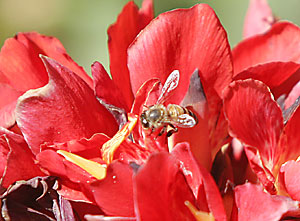 |
|
Jake Lacey/Arizona Daily Wildcat
|
Results released last month from a 2004 study show that a bumblebee will watch other bumblebees and imitate them to find which flowers are most popular and best to forage on. Bees have a natural tendency to follow other bees, even to flowers they wouldn't otherwise visit.
|
|
|
By Evan Pellegrino
Arizona Daily Wildcat
Wednesday, September 21, 2005
Print this
Just like people are influenced on where to eat and where to shop based on what other people are doing, bumblebees follow a similar pattern when it comes to deciding which flowers to forage, researchers said.
Results released last month from a 2004 study show that a bumblebee will watch other bumblebees and imitate them to find what flowers are most popular and best to forage on.
The experiment is similar to one Charles Darwin used to perform in his garden, said Brad Worden, a postdoctoral research associate and behavioral ecologist.
Worden and Daniel R. Papaj, professor of ecology and evolutionary biology, know that bees have a natural tendency to go to orange flowers, so they trained bees to go to green flowers, while another group of bees watched, Worden said.
One colony was used as "teacher" or "model bees" while another colony watched from a see-through chamber that allowed them to see but not interact, Worden said.
After 10 minutes the scientists turned off the lights, put out new flowers and released the observing colony. When the bees that were watching were released, they tended to go to the green flowers, Worden said.
"They copied the choice of the models bees they were watching, specifically with green flower," Worden said. "The bees went against their natural tendency based on what they saw other bees doing. Their innate preferences were reversed."
Humans and other social animals pay attention to others in their species, and bees, like people, are social organisms, Worden said.
"The basics of social learning can occur in all sorts of animals," Worden said.
If we learn why bees copy other bees, the knowledge of social learning can be applied to other species, Worden said.
"Social learning is very common in humans, especially teaching and learning," Worden said. "In bees we found a simple form of social learning."
Because the watching bees went to the same type of flower, opposed to the same exact flower, Worden said, they're picking types and trends of flowers based of observations.
The bees learned a behavior through their observations and applied it to new flowers of the same color, flowers that they didn't actually see other bees at. In other words, instead of just going where other bees were, they learned the other bee's trends.
When a bee forages on a flower it will leave a mark on the flower. Worden and Papaj changed the flowers before the observing bees were released, which made sure the bees were imitating purely on sight, Worden said.
Prior to the study it was known that bees communicate in the hive through "dances" that show other bees direction and distance.
The results of the bee behavioral study show that, "bees are paying attention out in the field by watching other (bees)," Worden said.
"By studying social learning in many different species, we get a better understanding of the general patterns," Worden said. "A question that isn't answered is when should you copy an individual and when should you use your own individual experience."
